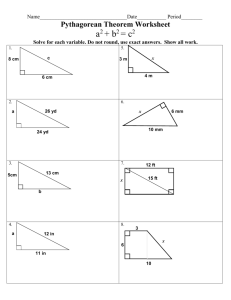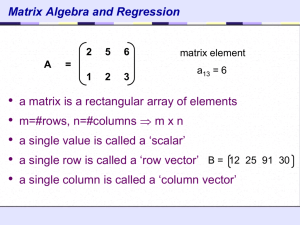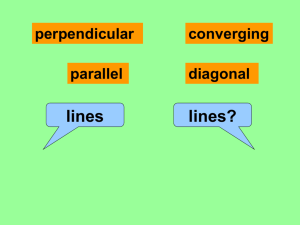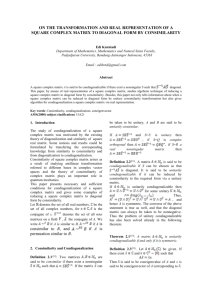A quantitative version of the commutator theorem for zero trace matrices ∗
advertisement
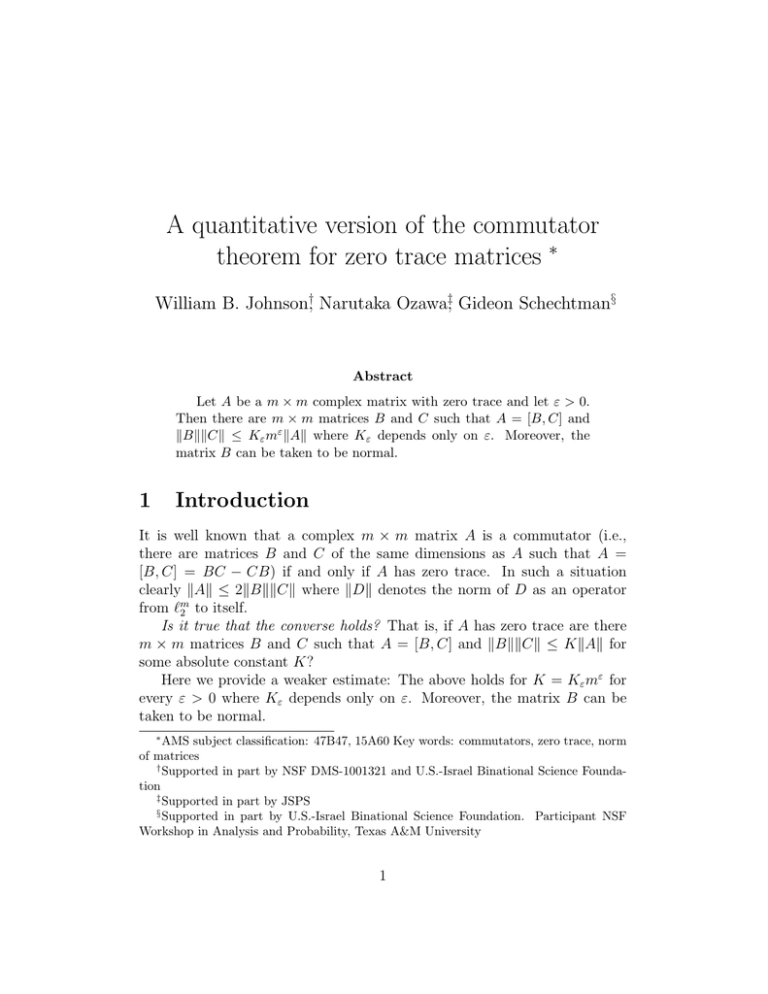
A quantitative version of the commutator
theorem for zero trace matrices ∗
William B. Johnson†, Narutaka Ozawa‡, Gideon Schechtman§
Abstract
Let A be a m × m complex matrix with zero trace and let ε > 0.
Then there are m × m matrices B and C such that A = [B, C] and
kBkkCk ≤ Kε mε kAk where Kε depends only on ε. Moreover, the
matrix B can be taken to be normal.
1
Introduction
It is well known that a complex m × m matrix A is a commutator (i.e.,
there are matrices B and C of the same dimensions as A such that A =
[B, C] = BC − CB) if and only if A has zero trace. In such a situation
clearly kAk ≤ 2kBkkCk where kDk denotes the norm of D as an operator
from `m
2 to itself.
Is it true that the converse holds? That is, if A has zero trace are there
m × m matrices B and C such that A = [B, C] and kBkkCk ≤ KkAk for
some absolute constant K?
Here we provide a weaker estimate: The above holds for K = Kε mε for
every ε > 0 where Kε depends only on ε. Moreover, the matrix B can be
taken to be normal.
∗
AMS subject classification: 47B47, 15A60 Key words: commutators, zero trace, norm
of matrices
†
Supported in part by NSF DMS-1001321 and U.S.-Israel Binational Science Foundation
‡
Supported in part by JSPS
§
Supported in part by U.S.-Israel Binational Science Foundation. Participant NSF
Workshop in Analysis and Probability, Texas A&M University
1
The proof will be presented in the next section. It is self contained except
for two facts. The first is a relatively easy result of Rosenblum [1] which gives
a solution for X of the matrix equation A = SX − XT where all matrices
are square and S and T have separated spectra in the sense that there is a
domain D, whose boundary is a simple curve, which contains the spectrum
of S and is disjoint from the spectrum of T . The solution then is:
Z
1
X=
(zI − S)−1 A(zI − T )−1 dz.
2πı ∂D
The second fact is a heavy theorem of Bourgain and Tzafriri [2] related to
restricted invertibility of matrices and to the Kadison–Singer conjecture. It
is stated as Theorem 1 in the sequel.
After two of us were led to this problem while considering classification
problems for commutators in spaces of operators on Banach spaces, one of
us raised the problem discussed here on MathOverFlow.net [3]. Although
the MO discussion did not produce a solution to the problem, it did put the
authors in contact with one another and the discussion itself contains some
useful tidbits.
2
The main result
Given 0 < ε < 1, define a sequence of sets Λn inductively: Λ1 is the set of 4
points {±1 ± ı1} and
Λn =
1+ε
1+ε
1−ε
Λn−1 + {±
±ı
}.
2
2
2
Note that Λn is a subset of the square [−1, 1] × [−ı, ı] of cardinality 4n and
that it consists of a disjoint union of 4 sets each of which is a translate
of 1−ε
Λn−1 and for each two of them their projection on either the real or
2
imaginary axis is 2ε separated.
As we shall discuss below, every square matrix with zero trace is unitarily
equivalent to a matrix with zero diagonal. It is thus enough to consider such
matrices A. In our main result the matrix B can then be chosen to be a
diagonal matrix. This is the reason for the definitions of µ and λ below. We
do not know if one can get better results with more general B.
Given a 4n × 4n matrix A with zero diagonal denote by µ(A) the smallest
number µ such that there is a diagonal matrix B with diagonal elements
2
exactly the points of Λn and a 4n × 4n matrix C such that A = [B, C] =
BC − CB and kCk ≤ µ. Note that since A has zero diagonal, for each
diagonal matrix B with distinct diagonal entries {bi } such a matrix C exist
and its non diagonal entries are uniquely defined by cij = aij /(bi − bj ). Put
also µ(4n ) = max µ(A) where the max ranges over all zero diagonal 4n × 4n
matrices of norm one.
Similarly, for m not necessarily of the form 4n , we denote by λ(A) the
smallest number λ such that there is a diagonal matrix B with diagonal
elements in [−1, 1] × [−ı, ı] and a m × m matrix C such that A = [B, C] =
BC − CB and kCk ≤ λ. Put λ(m) = max λ(A) where the max ranges over
all m × m matrices of zero diagonal and norm one.
Given a m × m, m = 4n , matrix A write it as a 4 × 4 block matrix with
blocks of size 4n−1 × 4n−1
A11 A12 A13 A14
A21 A22 A23 A24
A31 A32 A33 A34
A41 A42 A43 A44
Claim 1
µ(A) ≤
6kAk
2
max µ(Aii ) + 2 .
1 − ε 1≤i≤4
ε
In particular
µ(4n ) ≤
2
6
µ(4n−1 ) + 2 .
1−ε
ε
Also,
λ(A) ≤
6kAk
2
6
2
max λ(Aii ) + 2
and λ(4n ) ≤
λ(4n−1 ) + 2 .
1≤i≤4
1−ε
ε
1−ε
ε
(1)
Proof: Let Bii be diagonal matrices with diagonal entries in Λn−1 and Cii
4n−1 × 4n−1 matrices with Aii = [Bii , Cii ] and kCii k = µ(Aii ). Let
1−ε
1+ε
1+ε
0 4
{Bii }i=1 =
B a+1 +b+2, a+1 +b+2 + a
+ ıb
I4n−1
2
2
2
2
2
a,b=±1
(the order doesn’t matter), and, for i 6= j, let Cij0 be defined (uniquely) by
0
Aij = Bii0 Cij0 − Cij0 Bjj
.
3
Then by the result mentioned in the Introduction (see[1] or [4]),
Z
1
0
0 −1
Cij =
(zI − Bii0 )−1 Ai,j (zI − Bjj
) dz
2πı ∂Dij
where Dij is the boundary curve of any domain containing the spectrum of
0
. Since we can easily find such a
Bii0 and disjoint from the spectrum of Bjj
0
and of length
curve of distance at least ε from the spectra of Bii0 and Bjj
2
0
4 + 4ε < 8 we get that kCij k < ε2 kAij k.
2
Let Cii0 = 1−ε
Cii and set
0
0
0
B11 0
0
0 B22
0
0
B=
0
0
0
0 B33
0
0
0
0 B44
and
C = (Cij0 )i,j=1,2,3,4 .
Then
2
6
max µ(Aii ) + 2 kAk.
1 − ε i,i
ε
This gives the claim for µ and the proof for λ is almost identical.
kCk ≤
In the proof of the main theorem we shall use the parameter λ. The
reason we also included µ here is that the matrices B in the proof for the
property of µ depend only on ε and not on the matrices A. Optimizing over
ε we get
Corollary 1 (i) For each m there is a m × m diagonal matrix B with spectrum in the square [−1, 1]×[−ı, ı] such that for each m×m matrix A√with diagonal zero there is a m×m matrix C with norm at most O((log m)3 m)kAk
such that A = [B, C].
(ii) For each m = 4n there is a subset Λm of [−1, 1] × [−ı, ı] such that any
trace zero m × m matrix A there is a normal
√ matrix B with spectrum Λm and
3
a matrix C with norm at most O((log m) m)kAk such that A = [B, C].
Proof: For each 0 < ε < 1, m of the form 4n , and an m × m matrix A with
2ε
norm 1 and zero diagonal, Claim 1 gives, as long as ε62 ≤ 1−ε
µ(m/4), that
µ(m) ≤ 2
1+ε
µ(m/4).
1−ε
4
Let k be the largest natural number smaller than log4 m such that ε62 ≤
2ε
µ(m/4k ). (If no such k exists take k = log4 m and change the argument
1−ε
below a bit, getting a better estimate.) Then
1+ε k
1+ε k 2
6
) µ(m4−k ) ≤ (2
) (
µ(m4−(k+1) ) + 2 )
1−ε
1−ε 1−ε
ε
1+ε k 6
6
12 1 + ε k
) ( + ) ≤ 3 (2
) .
≤ (2
1 − ε ε3 ε2
ε
1−ε
µ(m) ≤ (2
For ε =
1
k
we get
3
µ(m) ≤ 12k 3 2k (1 + )k .
k
Since k is at most log4 m we get (i) to get (ii) use the fact (see e.g. [5] or
[6]) that any trace zero matrix is unitarily equivalent to a matrix with zero
diagonal.
Remark 1 The power 1/2 of m in the first part of Corollary 1 can’t be
lowered. Indeed, if B is any m×m diagonal matrix with spectrum
in [−1, 1]×
p
[−ı, ı] then there are i 6= j in {1, 2, · · · , m} with |i − j| ≤ 8/m. If A is the
m × m matrix with 1 in the i, j place and zero elsewhere and A = [B, C],
then
p it is easy to see that the absolute value of the i, j entry of C is at least
m/8.
2
Note that the constant 1−ε
in (1) is what leads to the power 1/2 of m in
1
the Corollary above. If we could replace it with 1−ε
we could eliminate the
power of m altogether and be left with only a log factor. The next Claim is a
step in this direction. The Claim, which has a proof similar to the previous
one, shows that if a zero diagonal 2m × 2m matrix A has its two m × m
central submatrices having substantially different λ values and the smaller
one is substantially larger than the norm of the matrix, then λ(A) is, up to
a multiplicative constant close to 1, basically the same as the larger of these
two values. This will be used in the proof of the main theorem.
Claim 2 Let
A11 A12
A=
A21 A22
be a 2m×2m matrix with zero diagonal where the Aij are all m×m matrices.
Assume also that λ(Aii ) ≤ ci where c1 /c2 < 1/4. Then
λ(A) ≤ (1 + K((c1 /c2 )1/2 + kAk/c1 ))c2
For some absolute constant K > 0.
5
Proof: Write Aii = Bii Cii − Cii Bii , i = 1, 2 where the Bii are diagonal
matrices with spectrum in [−1, 1] × [−ı, ı] and kCii k = λ(Aii ) ≤ ci . Assume
also that c1 < c2 . For any 1/2 > δ ≥ c1 /c2 put
0
B11
= (−1 + δ)I + δB11 ,
0
B22
= 2δI + (1 − 2δ)B22
and
0
= δ −1 C11 ,
C11
0
= (1 − 2δ)−1 C22 .
C22
Then Aii = Bii0 Cii0 − Cii0 Bii0 and the Bii0 -s are diagonal matrices with spectrum
0
in [−1, 1] × [−ı, ı]. Moreover, the spectrum of B11
lies to the left of the
0
vertical line <z = −1 + 2δ and that of B22 to the right of the vertical line
<z = −1 + 4δ. Also
max kCii0 k ≤ max{δ −1 c1 , (1 − 2δ)−1 c2 } =
i=1,2
c2
.
1 − 2δ
Define Cij0 , i 6= j ∈ 1, 2, by
0
Aij = Bii0 Cij0 − Cij0 Bjj
then, by the same argument as in the proof of Claim 1, using Rosenblum’s
result, kCij k ≤ KkAk/δ 2 for some universal K. Define
0
0
0
B11 0
C11 C12
0
0
B =
and C =
0
0
0
C22
0 B22
C21
then A = B 0 C 0 −C 0 B 0 , B is a diagonal matrix with spectrum in [−1, 1]×[−ı, ı]
and
c2
KkAk
kC 0 k ≤
+
.
1 − 2δ
δ2
Taking δ = (c1 /c2 )1/2 we get that
λ(A) ≤ (1 + K((c1 /c2 )1/2 + kAk/c1 ))c2
for some absolute constant K (which, a careful examination of the proof
shows, can be taken to be 4/π).
We next recall a theorem of Bourgain and Tzafriri [2].
6
Theorem 1 [2]. For some absolute constant K > 0, if A is a m × m matrix
with zero diagonal then for all ε > 0 there is a central (i.e., whose diagonal is
a subset of the diagonal of A) submatrix A0 of dimension bε2 m × ε2 mc whose
norm is at most KεkAk.
Consequently, If A is a norm one 2 · 4n × 2 · 4n matrix with zero diagonal
then for all l ≤ n there are 4l disjoint subsets σi of 1, 2, . . . , 2 · 4n each of size
4n−l such that all the submatrices corresponding to the entries in σi × σi have
norm at most K2−l .
Theorem 2 (i) For each ε > 0 there is a constant Kε such that for all m
λ(m) ≤ Kε mε .
(ii) For each ε > 0 there is a constant Kε such that for all m and every
m × m zero trace matrix A there is a normal matrix B with spectrum in
[−1, 1] × [−ı, ı] and a matrix C with norm at most Kε mε kAk such that A =
[B, C].
Proof: Let A be a 2 · 4n × 2 · 4n matrix with zero diagonal and norm
one. Let 1 ≤ l ≤ n and let A0 be the 4n × 4n submatrix corresponding to
l
l
the entries in ∪4i=1 σi × ∪4i=1 σi where σi are given by Theorem 1. Let Alii
denote the submatrix corresponding to the entries in σi × σi , i = 1, 2, . . . , 4l .
Divide 1, 2, . . . , 4l into 4l−1 disjoint sets each a union of 4 σi -s and let Al−1
ii ,
l−1
n−l+1
n−l+1
i = 1, 2, . . . , 4 , denote the 4
×4
submatrices corresponding to
the entries corresponding to these sets. Continue in this manner to define Asii ,
i = 1, 2, . . . , 4s for each s = 0, 1, 2, . . . , l where for s ≥ 1 Asii is a 4n−s × 4n−s
0
0
submatrix of one of the As−1
jj . Note that A = A11 .
Now, By Claim 1 for each ε > 0,
λ(A0 ) ≤
≤
≤
≤
≤
6
2
max λ(A1ii ) + 2
1 − ε 1≤i≤4
ε
2
2
2
6
2
max λ(Aii ) +
+1 2
1 − ε 1≤i≤16
1−ε
ε
......
!
l−1
l−2
2
2
2
6
l−1
max λ(Aii ) +
+ ··· +
+1
l−1
1−ε
1−ε
1−ε
ε2
1≤i≤4
!
l
l−1
2
2
2
6
n−l
−l
λ(4 )K2 +
+ ··· +
+1
,
1−ε
1−ε
1−ε
ε2
7
where the last step is the place we use Theorem 1. Now use Corollary 1 to
get that for some absolute constants K (not necessarily the same in each
row)
l
l−1
2
6
1
n−l
0
λ(4 ) + l
λ(A ) ≤K
(2)
1−ε
1−ε
ε2
l
l−1
6
1
2
3 n−l
≤K
(n − l) 2 + l
.
1−ε
1−ε
ε2
For ε = 1/l we get
λ(A0 ) ≤ K((n − l)3 2n−l + l3 2l )
and taking l = n/2 gives
λ(A0 ) ≤ Kn3 2n/2 = K(log m)3 m1/4 .
(3)
We managed to reduce the power of m in the bound on λ(A) from m1/2 to
m1/4 but only for a large submatrix. Next we are going to utilize Claim 2
to get a similar bound for the whole matrix. Let σ c = {1, 2, · · · , 2 · 4n } \
l
∪4i=1 σi and let A00 be the submatrix of A with entries in σ c × σ c . Put c1 =
K(log m)3 m1/4 and c2 = max{K(log m)7 m1/4 , λ(A00 )}. Then A, A11 = A0
and A22 = A00 satisfy the assumptions of Claim 2 with c1 , c2 . Consequently,
λ(A) ≤ (1 + K(log m)−2 ) max{K(log m)7 m1/4 , λ(A00 )}
where we continue to use K to denote a universal constant, possibly different
in different occurrences, and for m = 4n , n ≥ 1,
λ(2m) ≤ (1 + K(log m)−2 ) max{K(log m)7 m1/4 , λ(m)}.
Repeating the argument again reducing from matrices of size 4n+1 × 4n+1 to
ones of size 2 · 4n × 2 · 4n and combining with the above we get, for m = 4n ,
λ(4m) ≤ (1 + K(log m)−2 ) max{K(log m)7 m1/4 , λ(m)}.
Let k ≤ m be the largest power of 4 such that λ(k) ≤ K(log4 k)7 k 1/4 . Then
log4 m
Y
λ(4m) ≤
(1 + Ks−2 ) K(log k)7 k 1/4 .
s=log4 k+1
8
For some other absolute constant K this last quantity is at most K(log m)7 m1/4 .
We thus improved the previous bound on λ(m) (for m = 4n ) to
λ(m) ≤ K(log m)7 m1/4
for some absolute K.
Repeating the argument one can improve the bound further: Go back to
(2) and plug this new bound to get
0
λ(A ) ≤ K
1
1−ε
l
7 (n−l)/2
(n − l) 2
+l
2
1−ε
l−1
6
.
ε2
For ε = 1/l we get
λ(A0 ) ≤ K((n − l)7 2(n−l)/2 + l3 2l )
and taking l = n/3 gives
λ(A0 ) ≤ Kn7 2n/3 = K(log m)7 m1/6 .
replacing (3) with this new estimate and following the rest of the argument
above leads to
λ(m) ≤ K(log m)11 m1/6 .
Iterating, this leads to a bounds of the form:
λ(m) ≤ Kk (log m)4k−1 m1/2k
(4)
for every m = 4n and every positive integer k, where Kk depends only on
k. This gives the statement of the theorem for m being a power of 4. For
a general m × m zero diagonal matrix A, complete it to a 4n × 4n matrix
A0 where 4n−1 < m ≤ 4n by adding zero entries and keeping A supported
on {1, 2, · · · , m} × {1, 2, · · · , m}. Apply the theorem to A0 and note that
the fact that B is diagonal implies that we can assume that C has non zero
entries only in {1, 2, · · · , m} × {1, 2, · · · , m}. This proves the first part of
the theorem. The second follows from the fact that any trace zero matrix is
unitarily equivalent to a zero diagonal matrix.
9
3
Concluding remarks
1. Recall that the paving conjecture states that for every ε > 0 there is
a positive integer n(ε) such that any norm one zero diagonal matrix has a
paving of length at most n(ε) and norm at most ε. By a paving of A we
mean a block diagonal submatrix of A whose diagonal is the same as that
of A. The length of a paving is the number of blocks. Anderson [7] showed
that this conjecture is equivalent to the Kadison–Singer conjecture [8] on the
extension of pure states. For s recent expository paper on these conjectures
see [9].
It is clear from the proof above that if the paving conjecture holds with
the right parameters than the proof can be simplified and the main result
strengthened to get a polylog estimate on λ(m). We next show that the
reverse holds in a very strong sense. In particular if λ(m) is bounded independently of m then the paving conjecture holds.
Claim 3 Assume A = [B, C] with B a m×m diagonal matrix with spectrum
in [−1, 1] × [−ı, ı] and C an m × m√matrix. Then for every 0 < ε < 1 A has
a paving of length b 2ε c2 and norm 2εkCk.
Proof: Partition [−1, 1] into b 2ε c disjoint intervals Ii of length at most ε
each. Let B(i, j) be the central (diagonal) submatrix of B whose diagonal
entries are in Ii × ıIj , let A(i, j) and C(i, j) be the central submatrices of A
and C respectively with the same support as B(i, j). A(i, j), i, j = 1, 2, · · · ,
b 2ε c. A(i, j), i, j = 1, 2, · · · , b 2ε c, is a paving of A and it is enough to prove
√
that kA(i, j)k ≤ 2εkCk.
Clearly A(i, j) = [B(i, j), C(i, j)]. Pick i, j, let b be the center of the
square Ii × ıIj and note that bI − B(i, j) (with I the identity matrix of the
same dimensions√as B(i, j)) is a diagonal matrix with entries of absolute
value at most ε/ 2. Therefore
√
kA(i, j)k = k(B(i, j) − bI)C(i, j) − C(i, j)(B(i, j) − bI)k ≤ 2εkCk.
2. A more careful examination of the proof of Theorem 2 shows that the
constant we get in (4) is
λ(m) ≤ K k (log m)4k−1 m1/2k
10
for some absolute constant K. Optimizing over k gives
1/2
λ(m) ≤ mK(log log m/ log m)
for some absolute K.
3. It is quite easy to see that 1/2 is also the best constant for K in the
second paragraph of the introduction (assume A has zero diagonal and take
B to be diagonal
with diagonal elements 1/2 and −1/2). It also follows that
√
λ(2) = 1/2 2. We did not try to compute the best constants for other small
values of the dimension.
4. Although the problem we discuss seems basic enough not to need further
motivation, we would like to indicate one. If any trace zero matrix A could
be written as A = [B, C] with kBkkCk ≤ KkAk for a universal K, then we
would get a simple characterization of the commutators in an important class
of II1 factors, the Wright factors; an element there would be a commutator
if and only if it has zero trace. See [10] for this and related matters.
5. One can ask similar questions to the one addressed here for norms other
than the operator norm. In particular, what is the (order of) the best constant in
kBkkCkHS ≤ KkAkHS
where A ranges over all trace zero m × m matrices, A = BC − CB and k · kHS
denotes the Hilbert–Schmidt norm?
We checked that a proof with a similar idea but much simpler gives K =
O((log m)5/2 ).
References
[1] Rosenblum M (1956) On the operator equation BX − XA = Q. Duke
Math. J. 23: 263–269.
[2] Bourgain J, Tzafriri L (1991) On a problem of Kadison and Singer. J.
Reine Angew. Math. 420: 1–43.
[3] http://mathoverflow.net/questions/27345.
[4] Marcoux L-W (2006) Sums of small number of commutators. J. Operator
Theory 56 no. 1: 111–142.
11
[5] Fillmore P-A (1969) On similarity and the diagonal of a matrix. Amer.
Math. Monthly 76: 167–169.
[6] Halmos P-R (1982) A Hilbert space problem book. Second edition. Graduate Texts in Mathematics, 19. Encyclopedia of Mathematics and its
Applications, 17. Springer-Verlag, New York-Berlin.
[7] Anderson J (1979) Extensions, restrictions and representations of states
on C ∗ -algebras. Trans. AMS 249: 303-329.
[8] Kadison R, Singer I (1959) Extensions of pure states. American Jour.
Math. 81: 383-400.
[9] Casazza P-G, Edidin D (2007) Equivalents of the Kadison-Singer problem. Function spaces, 123-142, Contemp. Math. 435, Amer. Math. Soc.,
Providence, RI.
[10] Dykema K, Skripka A, On single commutators in II1 -factors.
http://arxiv.org/abs/1007.1701
W.B. Johnson
N. Ozawa
Department of Mathematics
Research Institute for Mathematical Sciences
Texas A&M University
Kyoto University
College Station, TX 77843 U.S.A. Kyoto 606-8502, Japan
johnson@math.tamu.edu
narutaka@kurims.kyoto-u.ac.jp
G. Schechtman
Department of Mathematics
Weizmann Institute of Science
Rehovot, Israel
gideon@weizmann.ac.il
12

